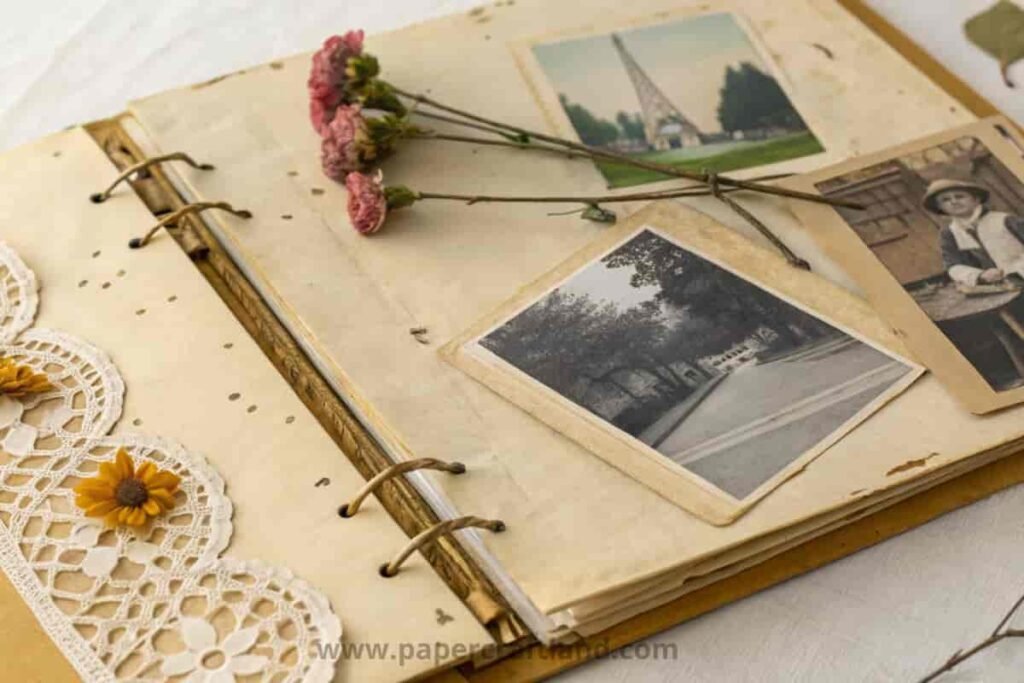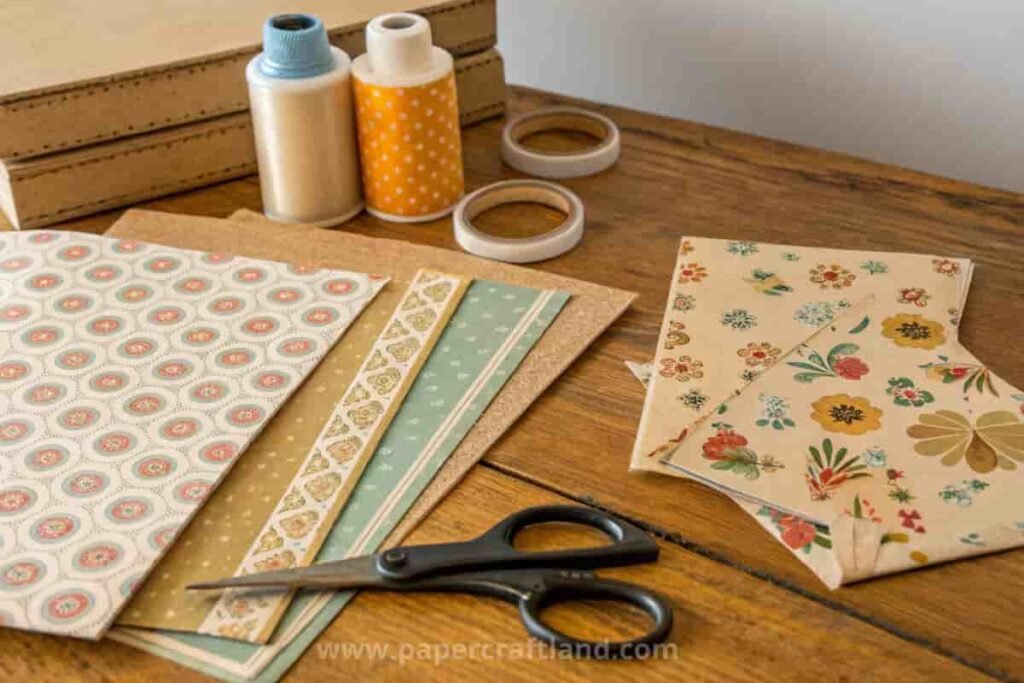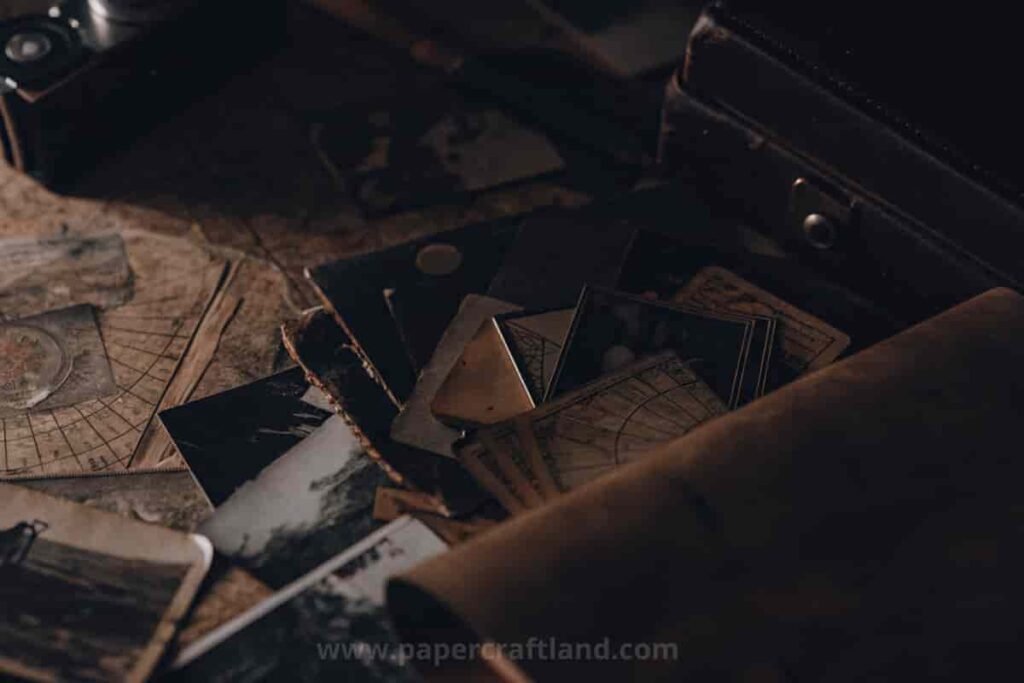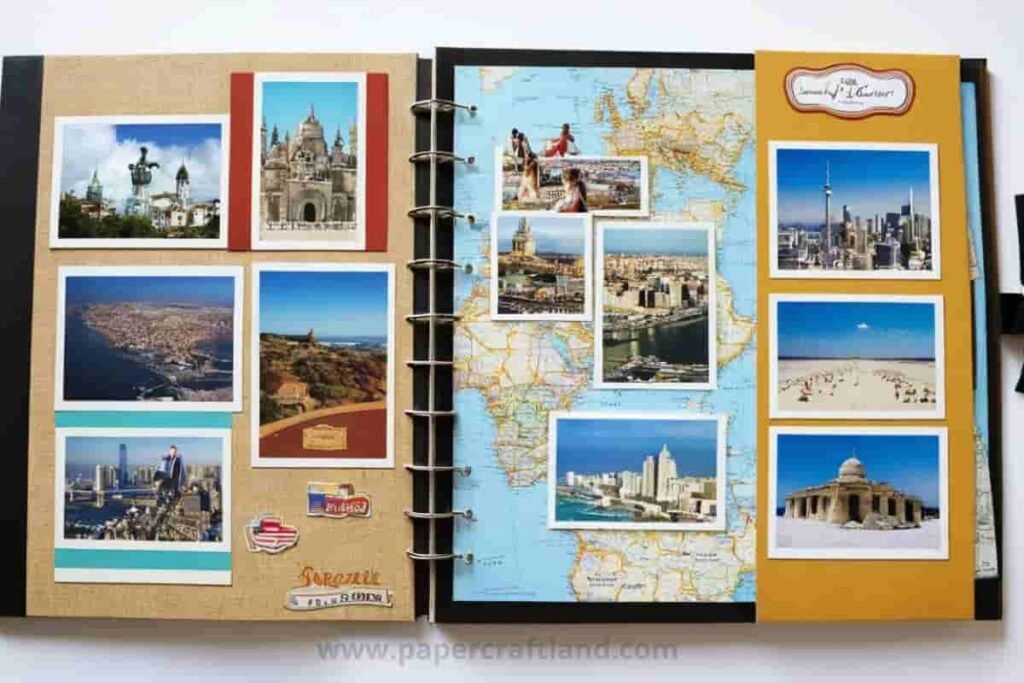Scrapbooking is more than just a craft; it’s a way to preserve memories, document personal stories, and creatively express oneself. Over the decades, scrapbooking has evolved, adapting to changing trends and technologies. One style that has recently experienced a resurgence is vintage scrapbooking, a nostalgic approach that harks back to earlier times.
Why the sudden revival? There’s something undeniably captivating about holding a beautifully crafted, tangible piece of art that tells a story through old photographs, ephemera, and hand-selected embellishments.
Vintage scrapbooking captures that charm and offers a deeper, more personal connection to memories, both for the creator and the viewer. In this article, we’ll explore the nuances of vintage scrapbooking, the materials you’ll need, and how to get started with this timeless craft.
- What is Vintage Scrapbooking?
- Essential Materials for Vintage Scrapbooking
- Getting Started with Vintage Scrapbooking
- Popular Themes in Vintage Scrapbooking
- Techniques to Achieve the Perfect Vintage Look
- Preserving Your Vintage Scrapbook
- The Art of Storytelling Through Vintage Scrapbooking
- Vintage Scrapbooking as a Gift
- How to Find Inspiration for Vintage Scrapbooking
- Where to Find Vintage Scrapbooking Supplies
- Digital Vintage Scrapbooking: A Modern Twist
- The Therapeutic Benefits of Scrapbooking
- Common Mistakes to Avoid in Vintage Scrapbooking
- Conclusion
- FAQs
What is Vintage Scrapbooking?
Definition and Origins of Vintage Scrapbooking
Vintage scrapbooking involves creating pages that evoke the past, often incorporating items and design elements from a bygone era. Think sepia-toned photographs, old lace trims, and time-worn letters tucked between pages.
This scrapbooking takes inspiration from history, whether it’s a family lineage, a specific historical period, or a general appreciation for antique aesthetics.
Difference Between Modern and Vintage Scrapbooking
While modern scrapbooking often features bright colors, digital elements, and a sleek finish, vintage scrapbooking leans heavily on textures, muted tones, and a weathered appearance. The aim is to evoke a sense of nostalgia, sometimes even transporting the viewer to a different time entirely.
This often involves the use of older materials and techniques, though modern tools can still be used to replicate vintage styles.
The Nostalgic Appeal of Vintage Scrapbooking
Many crafters are drawn to vintage scrapbooking because of the emotional connections it can foster. It’s not just about preserving a photo or a memento; it’s about storytelling, about honoring the past, and about grounding oneself in history.
There’s a certain magic in holding an old ticket stub or a postcard from decades ago these moments that vintage scrapbooking immortalizes.
Essential Materials for Vintage Scrapbooking
To create an authentic vintage scrapbook, you’ll need to gather specific materials that contribute to the overall aesthetic. Each of these items will help you build pages that tell stories from the past.
Paper Types and Patterns for a Vintage Look
The foundation of any scrapbook is the paper. For a vintage feel, look for papers in sepia tones, aged browns, faded blues, or muted floral patterns.
Vintage-style scrapbook papers often mimic designs from the 1920s to 1950s and include motifs like damask, toile, or delicate florals. Some specialty papers even feature faux aging with watermarks or edges that resemble old parchment.
Using Ephemera: Postcards, Tickets, and Old Letters
Ephemera is a crucial component in vintage scrapbooking. These are the bits and pieces from everyday life—old postcards, stamps, ticket stubs, or even handwritten letters.
They add an authentic touch to your pages and contribute to the overall theme. Flea markets, antique stores, and online shops are great places to find these treasures.
Vintage Embellishments: Lace, Buttons, and Ribbons
What makes vintage scrapbooks so charming are the intricate details. Lace doilies, satin ribbons, and buttons from old garments add depth and texture to the pages.
These embellishments can be sourced from fabric stores, second-hand shops, or your stash of old materials.
Tools of the Trade: Scissors, Adhesives, and Inks
Investing in the right tools is key for any scrapbooker. Scissors with scalloped or decorative edges can create unique cuts that resemble old-fashioned stationery. Adhesives that are archival-safe will ensure your pages last for decades without yellowing.
Finally, distressed inks and vintage-style stamps can add finishing touches that give your pages an antique appearance.
Getting Started with Vintage Scrapbooking

Once you’ve gathered your materials, the next step is to start planning your scrapbook. This process involves choosing a theme, selecting photographs, and organizing your layout.
Choosing a Theme for Your Vintage Scrapbook
The theme is the guiding force of your vintage scrapbook. Popular choices include family heritage, a romantic era, or even a specific decade like the 1920s or 1940s. Whatever theme you choose, make sure it ties your pages together cohesively and enhances the vintage aesthetic.
Selecting Photos with a Vintage Feel
While you can use modern photos in your vintage scrapbook, you might want to give them a retro touch by turning them into sepia tones or black-and-white images. This can be done through photo editing software or filters. Of course, using actual vintage photos—perhaps from a family collection—will add a layer of authenticity.
How to Arrange Your Layout
Layout is everything in scrapbooking, and vintage pages often feature a more organic, less structured design. Think about layering different elements—paper, photos, and ephemera—to create depth. Torn edges, uneven layers, and a collage-like approach can enhance the sense of age and history.
Popular Themes in Vintage Scrapbooking
Certain themes lend themselves particularly well to vintage scrapbooking, helping you to further explore personal or historical stories.
Family Heritage and Genealogy
Creating a family history scrapbook is a powerful way to document your genealogy. Start with old family photographs, birth certificates, and letters. Each page can tell the story of a different ancestor or event in your family’s history, with personal notes that tie the narrative together.
Vintage Travel Journals
Whether you’re documenting a road trip from the 1960s or a family vacation from the 1940s, vintage travel scrapbooks are a great way to highlight old tickets, maps, and postcards. Add handwritten notes about the journey and some vintage stamps to complete the look.
Romantic and Victorian-Inspired Pages
If you love the elegance of the Victorian era, you can create pages filled with floral patterns, lace, and romantic quotes. Love letters, dried flowers, and old perfume ads make beautiful additions to a Victorian-themed scrapbook.
Childhood and Nostalgia-Themed Scrapbooks
There’s something heartwarming about capturing childhood memories with a vintage flair. Use old-school photos, drawings, and report cards to create a nostalgic look back at your early years. You can even recreate a vintage baby book with antique-style embellishments.
Techniques to Achieve the Perfect Vintage Look
Creating a truly vintage aesthetic requires a few special techniques that mimic the passage of time.
Aging and Distressing Paper
Distressing paper is a popular technique to give your scrapbook pages an aged appearance. Use sandpaper, distressed inks, or even tea-staining to make the edges of your paper look worn and weathered.
Creating Sepia-Toned or Black-and-White Photos
If you’re using modern photographs, converting them to sepia or black-and-white tones can immediately give them a vintage look. Most photo-editing apps or software offer this feature, or you can use filters available on your smartphone.
Stamping and Stenciling for Vintage Effects
Stamps and stencils offer a creative way to add patterns and designs to your pages. Look for vintage-style stamps featuring cursive fonts, old-world maps, or botanical illustrations to complement your theme.
Handwritten Notes and Calligraphy Techniques
Adding handwritten notes to your scrapbook enhances its personal touch. If you want to get creative, try using a calligraphy pen or learning some basic calligraphy techniques. It gives your pages an elegant, old-fashioned feel that perfectly matches the vintage theme.
Preserving Your Vintage Scrapbook

Since vintage scrapbooks often include fragile materials, it’s important to take steps to preserve your work.
How to Properly Store a Vintage Scrapbook
Keep your scrapbook in a cool, dry place, away from direct sunlight or moisture. Store it in an archival-safe box or album that protects it from the elements. Always ensure that the pages are fully dried before storing.
Archival Techniques to Protect Delicate Materials
Using archival-quality paper, adhesives, and protectors will help your scrapbook withstand the test of time. Acid-free and lignin-free products are crucial in preventing your pages from yellowing or deteriorating.
How to Repair Old Scrapbook Pages
If you’re working on an old scrapbook that’s been passed down, you may need to repair damaged pages. Use special archival-safe tapes or glues to gently mend any tears. Be careful not to alter the original look too much, as this can detract from its authenticity.
The Art of Storytelling Through Vintage Scrapbooking
The beauty of scrapbooking lies in its ability to tell stories. Every page in a vintage scrapbook should have a narrative.
Using Journaling to Add Personal Touches
Journaling is a fantastic way to add context and personal reflections to your scrapbook. Write short captions or longer paragraphs to explain the significance of each photo or object. These personal touches will bring your scrapbook to life.
Creating Narratives That Tie Your Pages Together
Think of your scrapbook as a visual novel. Each page should flow into the next, whether it’s through a chronological timeline or a thematic link. Group photos and mementos together in a way that tells a cohesive story.
Vintage Scrapbooking as a Gift
A vintage scrapbook makes for a deeply personal and meaningful gift.
Personalized Vintage Scrapbooks for Special Occasions
Whether for a wedding, anniversary, or birthday, creating a personalized vintage scrapbook can be one of the most heartfelt gifts you can give. Include photos, memorabilia, and personal notes that capture important moments in the recipient’s life.
Creating Scrapbooks as Heirlooms
A vintage scrapbook can also serve as a family heirloom. Compile family photos, documents, and stories in a way that future generations will cherish. This makes for a timeless treasure that can be passed down through the family.
How to Find Inspiration for Vintage Scrapbooking
Sometimes inspiration comes from the most unexpected places. Here’s how to get your creative juices flowing.
Looking at Old Family Albums
Old family photo albums are a goldmine for vintage scrapbookers. Not only do they provide you with a rich collection of images, but they can also inspire layouts and themes for your scrapbook.
Drawing Ideas from Antique Stores and Flea Markets
Antique stores, flea markets, and garage sales are great places to find vintage materials and ideas. A simple item like an old postcard or piece of lace can spark an entire scrapbook theme.
Online Communities and Scrapbooking Groups
There’s a wealth of inspiration online, from Pinterest boards to scrapbooking forums. Many vintage scrapbookers share their work online, providing you with new ideas, techniques, and even tutorials.
Where to Find Vintage Scrapbooking Supplies

Finding the right materials for your vintage scrapbook can sometimes be a treasure hunt.
Sourcing Materials from Antique Shops
Antique shops are perfect for finding authentic vintage materials like postcards, buttons, and fabrics. You can often find unique items that will make your scrapbook truly one of a kind.
Buying Online from Specialty Stores
If you can’t find what you need locally, there are plenty of specialty scrapbooking stores online. Websites dedicated to scrapbooking supplies often have entire sections devoted to vintage-themed materials.
DIY Vintage Scrapbooking Materials
You can also create your vintage-inspired materials. For instance, you can “age” paper using coffee or tea, or design your embellishments using items you already have at home. DIYing some of your materials adds a personal touch that will make your scrapbook even more special.
Digital Vintage Scrapbooking: A Modern Twist
In recent years, digital scrapbooking has gained popularity, offering a modern take on a classic craft.
How to Create Digital Pages with a Vintage Aesthetic
Digital scrapbooking software allows you to create layouts that mimic the look of a physical scrapbook. Many programs offer vintage-themed backgrounds, embellishments, and effects like sepia tones and distressed edges. This is a great option for those who prefer working on a computer or who want to create scrapbooks for printing later.
Printing Digital Elements for Physical Scrapbooks
Even if you’re not creating a fully digital scrapbook, you can use digital scrapbooking elements to print vintage-style papers and embellishments for your physical book. Many designers offer printable elements that can be used to enhance your pages.
Digital Scrapbooking Software for Vintage Projects
Software like Adobe Photoshop, and Canva, or dedicated scrapbooking tools like Scrapbook MAX! and MyMemories Suite are fantastic for crafting digital scrapbook pages. Many of these programs have built-in templates and vintage design packs that can help you create your desired look.
The Therapeutic Benefits of Scrapbooking
Scrapbooking offers more than just creative satisfaction; it can also have mental health benefits.
Scrapbooking as a Form of Mindfulness
The act of scrapbooking can be meditative. Carefully choosing photos, arranging layouts, and piecing together a personal story requires focus and attention to detail. This mindfulness can help reduce stress and anxiety.
Creating a Sense of Connection with the Past
Vintage scrapbooking, in particular, allows you to reflect on the past in a meaningful way. Whether preserving family history or crafting a nostalgic theme, it fosters a connection with previous generations.
The Joy of Crafting Something Tangible
In a digital age, creating something with your hands is deeply satisfying. There’s a unique joy in seeing a physical scrapbook come together, knowing it will last for years.
Common Mistakes to Avoid in Vintage Scrapbooking

Scrapbooking is a rewarding and creative process, but there are some common pitfalls, especially when working with a vintage theme. Avoiding these mistakes will ensure that your scrapbook not only looks great but also stands the test of time.
Overcrowding the Pages
One of the most frequent mistakes in vintage scrapbooking is trying to fit too many elements onto one page. While it’s tempting to use all your beautiful ephemera, papers, and photos, overcrowding can make your pages feel chaotic and visually overwhelming.
How to avoid it:
Leave negative space on your pages to allow each element to breathe. Balance is key—focus on one or two focal points per page, such as a special photo or significant memorabilia. Let your embellishments complement the main elements rather than overpower them.
Not Using Archival-Safe Materials
Since vintage scrapbooks often aim to last for generations, using non-archival materials can lead to damage over time. Acidic papers, tapes, or adhesives can cause your photos and pages to yellow, deteriorate, or become brittle.
How to avoid it:
Always opt for archival-safe or acid-free materials. Look for paper, glue, tapes, and protectors specifically labeled as acid- and lignin-free to ensure longevity. Archival-safe materials prevent deterioration and help your scrapbook maintain its original beauty for decades.
Forgetting to Journal or Document Details
A scrapbook without captions or stories is just a photo album. Failing to include journaling or annotations about the photos and memorabilia can result in a disjointed or impersonal scrapbook. The stories behind the items are what make vintage scrapbooks meaningful.
How to avoid it:
Always include some form of journaling a simple date and location or a more elaborate story about the photo or object. Even a few words can provide context and add a personal touch, helping future generations understand the significance of your scrapbook.
Using Too Many Modern Elements
While blending modern and vintage elements can work, adding too many contemporary embellishments or digital designs can disrupt the nostalgic feel you’re aiming for in a vintage scrapbook. This can create a mismatched or jarring effect.
How to avoid it:
Stick to a consistent theme. If you do incorporate modern elements, make sure they harmonize with your vintage aesthetic. For example, if using modern fonts or designs, opt for ones that mimic vintage handwriting or antique styles. Always prioritize materials that contribute to the overall vintage look.
Over-editing Photos for a Vintage Look
It’s easy to go overboard when applying filters or edits to modern photos to give them a vintage appearance. Excessive sepia tones, grain, or distressing can sometimes make photos look unnatural or over-processed, rather than genuinely aged.
How to avoid it:
Use photo editing tools sparingly. Apply subtle sepia tones or black-and-white filters to modern photos, but avoid extreme effects. If possible, include a mix of authentic vintage photos along with lightly edited modern ones for a more balanced, natural look.
Neglecting Page Durability and Binding
Since vintage scrapbooks often use heavy papers and embellishments like buttons or thick ribbons, it’s essential to ensure the binding and page strength can handle the weight. Using flimsy pages or poor-quality bindings can lead to your scrapbook falling apart.
How to avoid it:
Invest in a strong, well-made scrapbook with sturdy binding. Choose heavier cardstock for your pages to support the weight of your materials, and consider reinforcing pages that include bulkier items like buttons or fabric swatches.
Ignoring Layout Planning
Jumping straight into crafting without considering a cohesive layout can result in haphazard or unbalanced pages. Without a layout plan, elements might clash or feel misplaced, leading to a scrapbook that lacks flow or consistency.
How to avoid it:
Plan your layouts before gluing or affixing anything permanently. Arrange your materials and photos on the page first to see how they look together. Consider the flow between pages, and how one layout leads to the next. Use sketches or a layout template if needed.
Using Inconsistent Color Palettes
A mismatched color palette can disrupt the vintage vibe of your scrapbook. Bright, modern colors can clash with more muted, antique tones and detract from the nostalgic feel you’re trying to achieve.
How to avoid it:
Stick to a cohesive color scheme that reflects the era or theme you’re going for. For vintage scrapbooks, opt for muted tones, sepia, cream, browns, faded pastels, or antique gold. Consider the colors in your photos and ephemera to ensure everything blends harmoniously.
Not Considering Long-Term Preservation
Vintage scrapbooks are often made to be cherished for years or even passed down as family heirlooms. Not considering how to protect your pages and materials over time can lead to fading, wear, and damage.
How to avoid it:
Use protective covers or plastic sleeves to safeguard your pages. Consider using UV-resistant protectors to prevent fading if your scrapbook is exposed to light. Store your scrapbook in a cool, dry place to avoid moisture or heat damage.
Overuse of Vintage Filters and Effects
While the goal of a vintage scrapbook is to evoke the past, going overboard with vintage effects like distressing, aging, or applying too many filters can make your project feel artificial or forced.
How to avoid it:
Subtlety is key. Rather than distressing every element, choose a few focal points to age or antique, and let other elements remain clean or natural. This creates contrast and ensures your project doesn’t look overly manipulated.
By avoiding these common mistakes, you can create a vintage scrapbook that is visually stunning but also well-crafted and long-lasting. Each page should balance creativity with preservation, resulting in a beautiful keepsake that will stand the test of time.
Conclusion
Vintage scrapbooking is a rewarding, timeless craft that allows you to create beautiful, personal keepsakes. Whether preserving family history, reminiscing, or simply indulging in a creative hobby, vintage scrapbooking offers a unique way to blend artistry and storytelling.
With the right materials, techniques, and inspiration, anyone can create a vintage scrapbook that will be cherished for generations. So why not gather your supplies, dive into your family archives, and start your vintage scrapbooking journey today?
FAQs
1. What makes vintage scrapbooking different from modern scrapbooking?
Vintage scrapbooking focuses on creating a nostalgic, aged aesthetic using muted colors, antique embellishments, and ephemera from the past. Modern scrapbooking often uses bright colors and digital elements.
2. How can I find vintage materials for my scrapbook?
You can find vintage materials at antique stores, flea markets, online specialty stores, and even by creating your DIY aged paper or embellishments.
3. Are there digital tools for creating a vintage scrapbook look?
Yes! Digital scrapbooking software like Photoshop or Canva allows you to create layouts with vintage-style elements. Many programs have built-in templates and effects to achieve a retro look.
4. Can vintage scrapbooking be done on a budget?
Absolutely. You can find many vintage-style materials at thrift stores, garage sales, or online at affordable prices. DIY options, such as aging paper with coffee or tea, can also save money.
5. What themes work best for vintage scrapbooks?
Popular themes include family heritage, romantic or Victorian-inspired pages, vintage travel journals, and childhood nostalgia.
6. Can I mix modern and vintage elements in my scrapbook?
Yes, blending modern and vintage elements can create a unique look. Just ensure the styles complement each other to maintain a cohesive design.
7. How long does it take to complete a vintage scrapbook?
The time varies depending on the complexity, but most projects can take weeks to months, depending on how detailed you want it to be.
8. What is the best way to organize a vintage scrapbook?
Organize by theme, era, or story to create a clear narrative. Use dividers or chapters to keep each section distinct and easy to follow.




